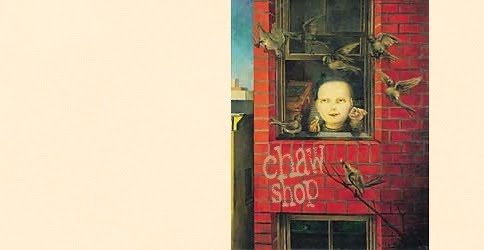When I was a kid, I watched gangster movies with my dad. My mother has never liked violent films, so I think he was pleased that he finally had someone he could share pistol whippings, broken glass, car chases, shoot-outs, and double-crosses with, even if it was his eleven-year-old daughter. To my credit, though I sometimes covered my eyes, even at that age I loved these movies, which I will generally call "film noir," despite the fact that some people use that term only to refer to the films of the 1940's and 50's. One of the main things that intrigued me about them were the characters, who were not like any characters I'd seen before.
A lot of movies intended for children actually do have intense violence, or at least intensely disturbing action. Parents die, siblings die, a kid has to KILL HIS OWN DOG OR BE KILLED WTF (Old Yeller). However, two things are notable about the role this violence plays in the story. First, it almost always takes place off-screen. There are a handful of exceptions to this, but even when the violence is glimpsed, it is not visually articulated -- there's not an interest in distilling it, stylizing it, extending it, exploring it, for maximum intensity. Second, the violence in kids' movies is always entirely justified or entirely evil, and accordingly, the characters themselves are either good or bad.
Side note: I am using "kids' movies" here as the name of a genre. There are certainly some movies intended for children that do not meet the criteria I'm describing here -- Time Bandits and Tideland by Terry Gilliam, the films of Tim Burton, the Dark Crystal, and Babe Pig in the City, for example, all use violence and shading in a way that is notably unusual for their intended audience. I'm also not slamming "kids' movies" as a genre: Disney's best animated films are masterful, decadent romps, as pleasurable to watch as the Beatles are to listen to. But I'm seeking here to contrast the logic of their fictive worlds with the logic of noir -- a very different animal indeed.
When I began watching noir, I was struck with the knowledge that the characters I saw were real, in a way that the inhabitants of Sleeping Beauty's castle were not. At the time, I couldn't articulate why this was. Considering my sheltered and privileged suburban existence, my reality was probably actually closer to that of a princess in a tower, and it would have been easy to dismiss my reaction to the films of Scorsese et al as a knee-jerk response to their appearance of grittiness, in the same way that a beggar's subway pitch might engage us with its pitiful details ("I'm thirty-two years old, an Iraq war veteran, and my cat and I are both HIV positive") while still being a lie. However, now that I'm older, I can see what it is that I was responding to.
When violence is played out on screen, when it is a significant part of the action in a movie or novel, the literal tangibility of the characters is revealed to us. When a character like Jack Nicholson's in Chinatown walks around for the whole movie with a bandage on the side of his face, or Leonardo DiCaprio's arm is broken completely and with enthusiasm in The Departed, we are placed not outside of those characters, using their story to learn a moral lesson, but inside of their bodies: "That's gotta hurt." (Sex in movies functions the same way. In the truly erotic, we also -- and more happily -- project ourselves literally into the skin of another character.)
Moreover, a well-done scene of violence, like any well-done scene, is not reducible to a simple, "And then that happened." When violence is played out in scene, the importance is shifted from the fact that the violence happened to the way it happened. I remember the first time I saw the film LA Confidential, a movie I became obsessed with for most of junior high. At the beginning of the movie, there is a terrible scene of police brutality: wrongly believing that several Hispanic prisoners in custody sent their colleagues to the hospital, a bunch of drunken cops go down to the holding pen and beat them within an inch of their lives. The scene is horrifying, but the moment I remember is when Jack Vincennes, the character played by Kevin Spacey, steps into the fray to break things up. He's a nice guy, but arrogant, a dandy, and one of the prisoners knocks into him, getting blood on his white jacket and tie. Vincennes promptly punches him in the face. Does this excuse his actions, even in the context of the story? No. Does it explain them? Unfortunately, yes. Though we may still condemn him, seeing the violence as it actually plays out forces us to understand him -- which leads to the disturbing feeling of complicity many people complain about in violent films.
Again, this is not to say that violent films for adults cannot be just as empty and stupid and disappointing as hideous children's shit like Water Horse: Legend of the Deep. But I do think that, often, violence in a movie can serve a purpose nothing else can.
That's right, kids: sometimes violence is the answer.

No comments:
Post a Comment